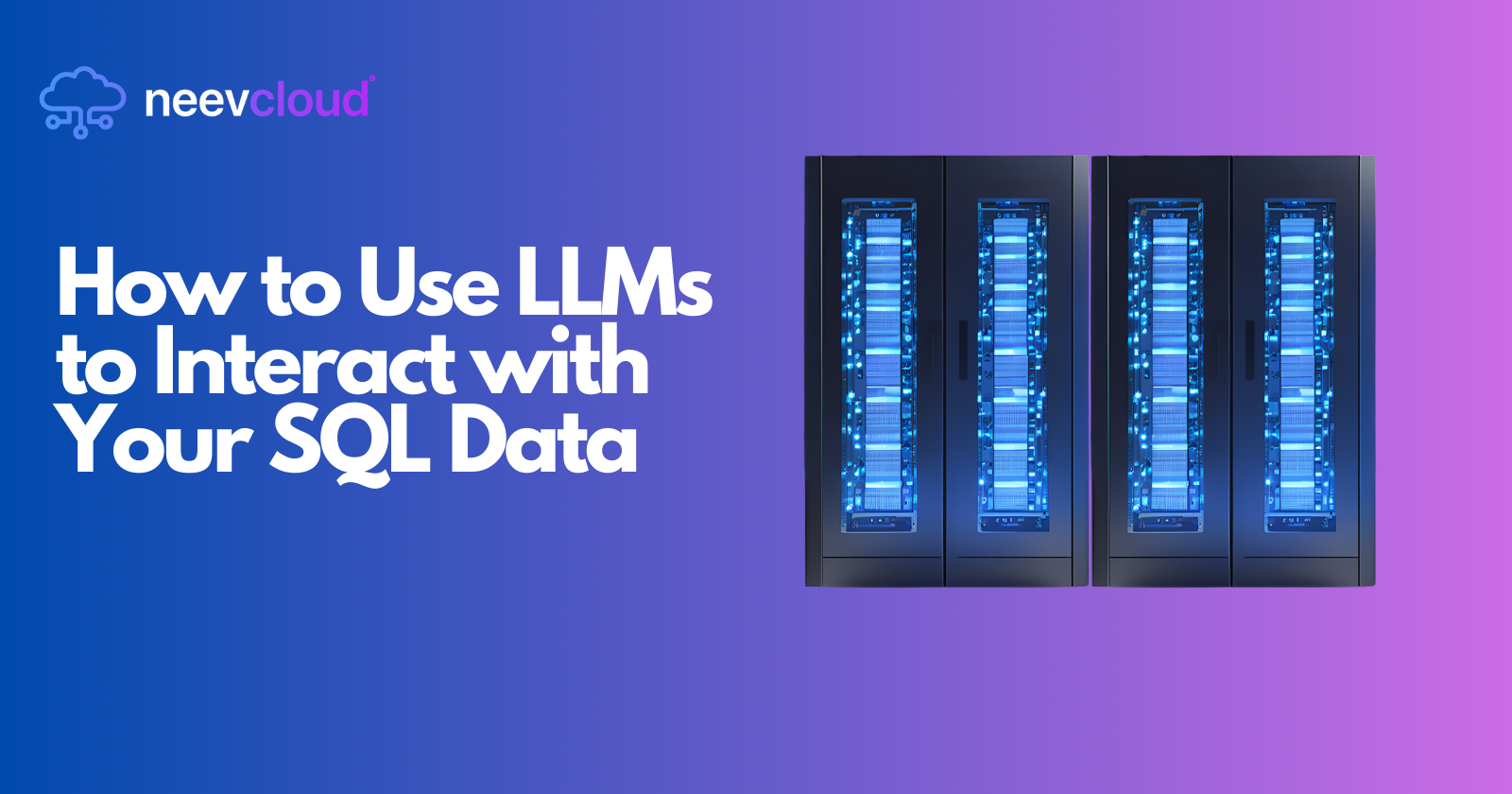How to Use LLMs to Interact with Your SQL Data
 Tanvi Ausare
Tanvi Ausare
As the demand for real-time data insights grows, so does the need for efficient and accessible data querying. Today, the power of large language models (LLMs) within the AI cloud has made it easier than ever to directly interact with structured data stored in SQL databases. This blog will explore how you can leverage LLMs to interact with SQL data, how it transforms data access, and how AI-powered datacenters can streamline complex data workflows.
Key Benefits of Using LLMs to Interact with SQL Data
Before diving into implementation, it’s important to understand why LLMs are advantageous for interacting with SQL databases:
Enhanced Accessibility: With LLMs, anyone—even without SQL expertise—can access data using natural language.
Faster Query Turnaround: LLMs can quickly interpret user intent and generate efficient SQL queries.
Automated Data Insights: By utilizing AI cloud resources, LLMs can autonomously analyze SQL data for trends and insights, delivering valuable outputs.
Reduced Need for Technical Knowledge: Non-technical team members can access and analyze SQL data without requiring SQL training.
Steps to Integrate LLMs with SQL Data
Using LLMs to query SQL data involves setting up an AI cloud environment, selecting or training a suitable model, and implementing a seamless querying system.
1. Setting Up the AI Cloud Environment
Start by selecting a cloud-based AI environment capable of handling LLMs and SQL operations, such as NeevCloud, which is optimized for AI workloads and data-intensive applications.
Choose an AI-friendly Cloud Provider: Opt for AI clouds with support for LLMs, such as NeevCloud. These environments provide GPUs and CPU resources that support model inference and data retrieval.
Enable Scalable Resources: For large datasets or high-frequency querying, consider a scalable setup to manage resource demand dynamically.
Database Integration: Ensure the SQL database is integrated with the cloud environment. This can be achieved by using managed database services or by connecting on-premise databases to the AI cloud.
2. Selecting or Training an LLM for SQL Querying
Choosing the right LLM for SQL interaction depends on your organization’s needs. Pre-trained models or custom fine-tuning are both viable options, depending on query complexity and data specifics.
Popular Pre-trained LLMs: Use models such as OpenAI’s GPT series or Meta’s LLaMA if general SQL querying capabilities suffice.
Training on Domain-specific Data: If your SQL database has unique data types or specific querying needs, fine-tune an LLM on domain-specific data.
Prompt Engineering: Customize prompt formats to elicit SQL query generation, reducing manual editing and ensuring accurate query creation.
3. Implementing Query Handling and Processing Logic
Implementing an interface between the LLM and the SQL database involves designing a process for interpreting user input, generating SQL queries, and handling responses.
Natural Language Processing Layer: Establish an NLP layer that interprets user requests and pre-processes them before passing them to the LLM.
Query Generation Module: Configure the LLM to generate SQL queries based on natural language prompts. This may involve designing a prompt format that specifies query structure, conditions, and output format.
SQL Execution and Result Handling: Once the LLM generates the SQL query, route it to the database and manage the result data by formatting it in a readable manner for the end user.
4. Enabling User-friendly Interfaces
The usability of your SQL-LLM system depends heavily on its interface. Make it as intuitive as possible for users unfamiliar with SQL.
Build a Chat-like Interface: Set up an interactive chat interface where users can input queries in plain English, and the system translates them into SQL.
Natural Language Query Suggestions: Guide users by suggesting example queries, helping them ask the right questions for their data.
Clear Error Handling and Feedback: In cases of unsupported queries or syntax errors, implement friendly error messages with suggestions for rephrasing.
5. Leveraging AI Datacenters for Performance Optimization
AI datacenters, like those powered by NeevCloud, offer specialized hardware (GPUs and TPUs) and optimized software for efficient LLM processing, which is essential for real-time SQL querying.
Accelerated Processing with GPUs: Large LLMs demand intensive computation, making GPU-based datacenters crucial for managing workloads and reducing response times.
Data Security and Compliance: Ensure that sensitive data is handled securely within the AI datacenter, especially when querying proprietary or PII-laden SQL databases.
Resource Optimization: Many AI datacenters offer dynamic resource scaling, allowing for cost-efficient operation by allocating resources only as needed.
6. Testing and Fine-tuning for Query Accuracy
To provide reliable SQL query responses, test the LLM’s output against various prompts and data scenarios, optimizing wherever necessary.
Test with a Diverse Set of Queries: Cover multiple SQL functions—SELECT, JOIN, GROUP BY, etc.—to ensure the LLM handles different types of queries accurately.
Error Checking and Correction: Implement mechanisms to validate query syntax and logic, correcting common errors the LLM might make.
Iterative Improvement: Track query performance, user feedback, and success rates to continually fine-tune prompt engineering and LLM response quality.
Best Practices for LLM-Driven SQL Querying
For optimal outcomes when deploying LLMs in SQL querying, keep these best practices in mind:
Establish Clear Usage Policies: Set boundaries on query complexity and frequency to manage resource usage effectively.
Monitor Query Accuracy and Latency: Regularly review generated SQL queries to ensure accuracy, and keep latency within acceptable bounds for real-time querying.
Optimize Prompts: Adjust prompts based on common user requests, streamlining SQL generation and improving response relevance.
Build Feedback Loops: Use feedback mechanisms to capture user satisfaction with query results, providing data to further improve model performance.
Key Advantages of Deploying LLMs for SQL Interactivity in AI Cloud
With LLMs integrated into SQL querying workflows, organizations stand to gain significantly. Here’s how:
Enhanced Data Accessibility for Non-technical Users: By allowing users to interact with SQL databases through natural language, LLMs democratize data access.
Streamlined Decision-making: Access to instant data insights accelerates decision-making, enabling leaders to act based on up-to-the-minute information.
Reduced IT Workload: With fewer requests for SQL queries from non-technical departments, the IT team can focus on strategic priorities.
Cost-efficient Infrastructure: AI clouds, like NeevCloud, are equipped to handle the compute demands of LLMs cost-effectively, providing a scalable solution that adapts to workload demands.
Conclusion
Large language models bring unprecedented accessibility and efficiency to SQL querying, making structured data more usable and interactive. By leveraging an AI cloud infrastructure like NeevCloud, deploying LLMs for SQL interaction becomes both a practical and a strategic advantage, enabling organizations to harness real-time insights without relying solely on SQL-savvy personnel.
Whether used by business leaders, analysts, or operations teams, this integration opens doors to faster, smarter, and more accessible data interactions. For organizations looking to maximize the potential of their data, LLM-powered SQL querying is a powerful next step.
Subscribe to my newsletter
Read articles from Tanvi Ausare directly inside your inbox. Subscribe to the newsletter, and don't miss out.
Written by
